Restoration Science
ESF Bee Lab
North America’s native pollinators are essential to ecosystems and agriculture, and many are facing serious population declines due in large part to habitat loss. However, for many species, we still lack crucial information about their distribution and habitat needs, as well as how they respond to management, making it difficult to take conservation action to protect them. There is also a growing public demand for regionally specific information about northeast native pollinators and the plants that support them, to foster conservation at the community level.
The ESF Bee Lab is a leader and partner in numerous research, restoration, and outreach efforts to better understand and conserve North America’s native pollinators. Learn more about who we are, and our current initiatives, below.
This work would not be possible without the generosity of the Betsy and Jesse Fink Family Foundation. Are you interested in sponsoring RSC research or donating to our mission?
Meet the Team
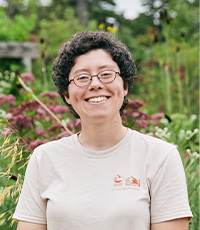
Molly Jacobson, Email
Pollinator Ecologist
Molly is involved with a wide variety of pollinator research projects, habitat creation and management efforts, and public outreach activities. She co-chairs the Bee Campus program, and also provides species-level identifications for most bee specimens that pass through the lab. Areas of interest include rare and specialist bees, plant-pollinator interactions, citizen science, native plant propagation, and raising awareness of the importance of understudied and underappreciated pollinator habitats.
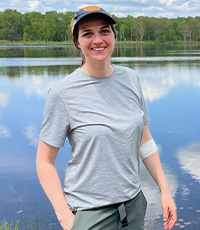
Paige Chesshire, Email
Postdoctoral Research Associate
Paige manages the rights-of-way project that surveys pollinator, plant, and bird species across company managed lands in the Lower Hudson Valley, with an emphasis on native bees. Additional areas of interest include local plant-pollinator interaction networks across various spatial and temporal scales, bee species data trends across regions, and promoting the importance of studying wild bee populations across North America.
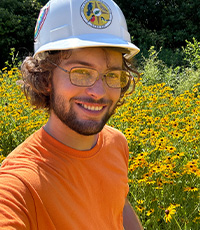
Jacob Keller, Email
MSc Student, Environmental & Forest Biology
Jacob is studying the biology, distribution, and ecology of the oligolectic bee Melitta eickworti (deerberry blunthorn bee) and the function of transmission line rights-of-way as critical habitat for the bee and its host plant.
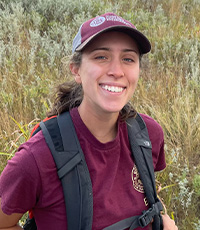
Elsa Klotz, Email
MSc Student, Environmental Biology
Elsa is assessing the performance of the seed mixes used in the pollinator habitat restoration of electrical transmission rights-of-way.
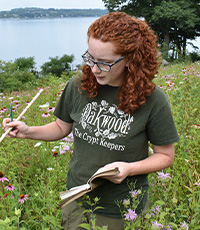
Elise Calahan, Email
Lawn to Meadow Coordinator
As part of the RSC’s Lawn to Meadow Program, Elise mostly coordinates with private land owners to collect plant, invertebrate, pollinator, and soil data in meadows established through the program. She uses the data to monitor meadow growth, as well as improve our understanding of artificial meadow systems' ecosystem services, creation, and management.
Bee Campus
ESF’s chapter of the national Bee Campus USA program is managed in a partnership between the Restoration Science Center and ESF’s Office of Sustainability. Bee Campus USA, and its sister program Bee City USA, is a nationwide initiative to increase the amount of urban native pollinator habitat, reduce pesticide use, and empower local conservation efforts through public outreach and community engagement. Since 2022, the Bee Campus program at ESF has added several major native plantings to campus grounds totaling over 15,000 sq ft, which not only provides year-round pollinator habitat, but enhances campus aesthetics and offers numerous teaching and recreational opportunities for students. Hundreds of the plants used in these installations are grown from wild local or regional ecotype seed right on campus. Bee Campus also hosts numerous outreach events, serving local school groups, nature centers and nonprofits, and the general public. The program also educates ESF students about pollinator ecology and conservation through course curriculum, paid and volunteer opportunities, and citizen science.
More Information on ESF's Bee Campus
Links
Bee Campus Native Plant Resources for New York
ESF Pollinators iNaturalist Project
Xerces Society for Invertebrate Conservation official Bee Campus USA website
Spotlight on Recent Research
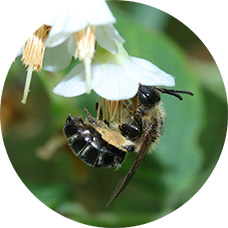
Powerline Right-of-Way Pollinators
In partnership with two New York electrical companies, this three-year project seeks to evaluate pollinator, plant, and bird communities underneath powerline rights-of-way (ROWs) and other electrical facilities in the lower Hudson Valley. These corridors can provide high quality habitat for wildlife and pollinators due to periodic management that reduces woody vegetation height and density, keeping them in an early successional state dominated by native shrubs, grasses, and forbs. Many rare and specialized bee species occur in these managed habitats due to the plant communities and soil types they support, and thus are dependent on continued management. The project has thus far documented numerous regionally rare pollinator species, including new state records, and ultimately will produce recommendations for ongoing management and future restoration to enhance habitat quality for rare and at-risk species along powerline ROWs in the northeast.
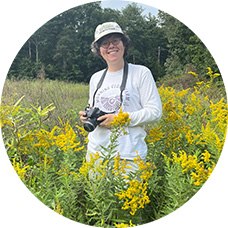
Healthy Soil Through Maximum Biodiversity
This ongoing project is in collaboration with Evan Abramson of Landscape Interactions LLC, an ecological landscape design firm based in Massachusetts. The project aims to improve biodiversity and soil health on agricultural lands in western Massachusetts through the creation of habitat for locally at-risk pollinators on working farms. Pollinator ecologist Molly Jacobson has conducted the fieldwork for this project, documenting baseline pollinator communities and plant-pollinator interactions at farms along a rural to urban gradient in western Mass. These data will be used to inform planting designs and track the success of upcoming plantings to attract target pollinators. A final product will be reproducible ‘toolkits’ that farms anywhere in the region can implement to create effective habitat that has benefits for pollinators, climate resilience, and local communities.
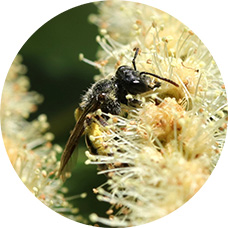
American Chestnut Pollinators
In 2023, in partnership with the American Chestnut Research & Restoration Project at ESF, the Bee Lab conducted an investigation of the pollinating insects that visit American Chestnut flowers in New York’s chestnut orchards. It is not fully understood the extent to which chestnuts rely on insect pollination, and which insects might contribute most – this study documented a rich diversity of bees, flies, beetles, and others visiting chestnut catkins, with beetles most frequently carrying chestnut pollen on their bodies. Several species of bees also collected chestnut pollen for their nests, indicative of the tree’s importance for native bees. A very notable find was the chestnut mining bee (Andrena rehni) at an orchard in Westchester County, a rare chestnut specialist that had not been seen in New York for 119 years. This bee has only been found in a handful of locations nationwide in the last decade, before which it had not been documented at all for several decades, leading many researchers to fear it had gone extinct following the loss of its chestnut hosts.
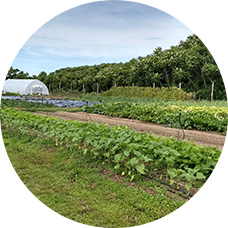
Martha’s Vineyard Pollinator Pathways
This project, a collaboration between the Besty and Jesse Fink Family Foundation and the Martha’s Vineyard Atlas of Life (hosted by the nonprofit BiodiversityWorks), completed its three year pilot study at the end of 2024. This initiative seeks to improve habitat for native pollinators, especially specialist bees, on farms on the island of Martha’s Vineyard, Massachusetts. Plots of plant species specially chosen for the island’s growing conditions and for local pollinator value were monitored for plant success, plant-pollinator interactions, and pollinator diversity. Pollinator ecologist Molly Jacobson assisted on the project, providing many specimen identifications, contributing to data collection at field sites, and offering expertise on project outcomes. The project has documented several regionally rare species and even new island records, indicating how sustainably managed farms can support a rich pollinator fauna, to the benefit of both nature and people. See project results at the Martha’s Vineyard Atlas of Life website.
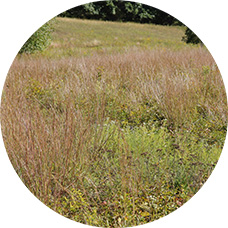
Pollinate Now! Hudson Valley
In 2022 the ESF Bee Lab partnered with Evan Abramson of Landscape Interactions LLC, and Dr. Robert Gegear of UMass Dartmouth (creator of the Beecology project), on a watershed-wide initiative to create corridors of diverse, resilient native habitat targeted at supporting locally at-risk pollinator species. Pollinator ecologist Molly Jacobson conducted fieldwork for this project, documenting baseline pollinator communities and plant-pollinator interactions at Hudson Valley sites to inform management actions and native planting lists. The final products of this project included reproducible ‘toolkits’ of planting designs each applicable to different land-use settings throughout the mid-Hudson Valley, custom-tailored for at-risk and specialist native pollinators in the region. Check out the public website for this project, and the full bioregional strategy (available for digital or physical purchase) at Landscape Interactions.
Peer-reviewed Publications
NYS Pollinator Spotlight
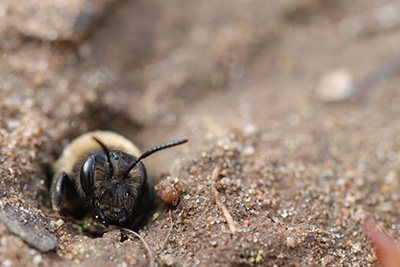
Andrena regularis
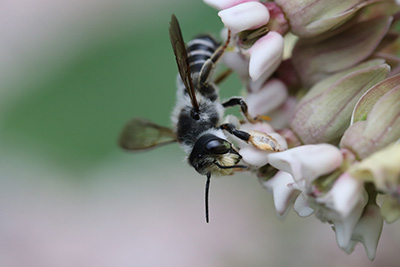
Megachile pugnata
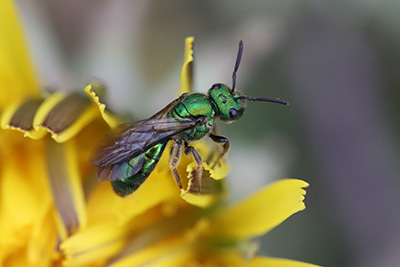
Augochlora pura
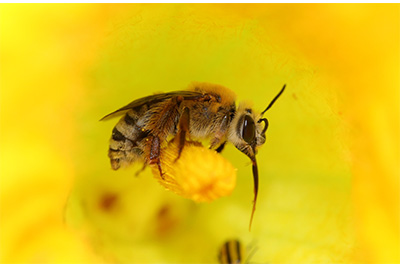
Peponapis pruinosa
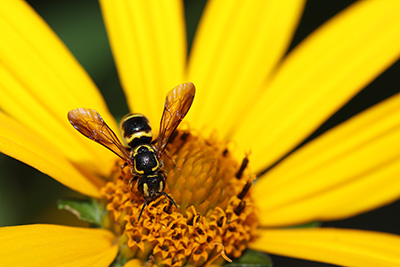
Stelis louisae
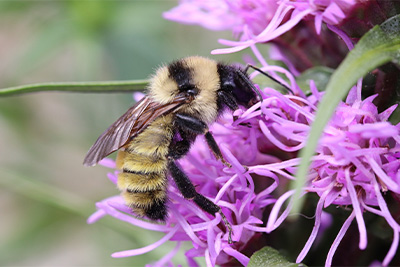
Bombus fervidus
All photos by Molly Jacobson.
